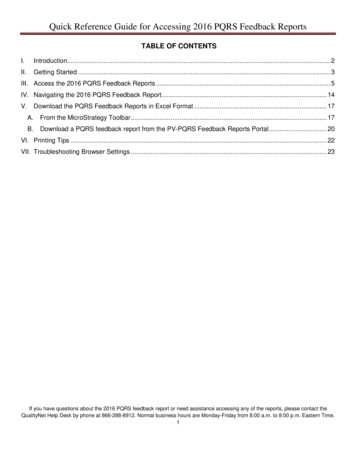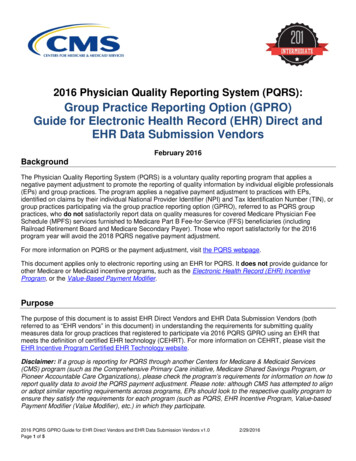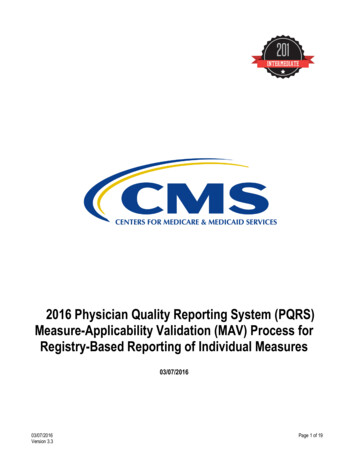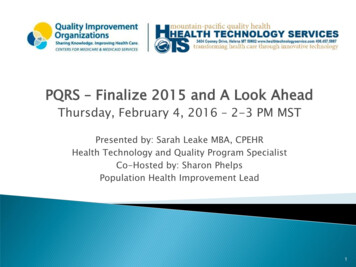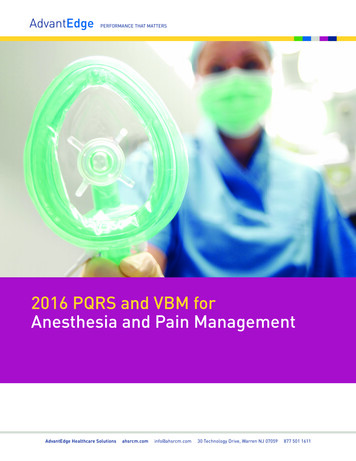
Transcription
PERFORMANCE THAT MATTERS2016 PQRS and VBM forAnesthesia and Pain ManagementAdvantEdge Healthcare Solutionsahsrcm.cominfo@ahsrcm.com30 Technology Drive, Warren NJ 07059877 501 1611
PERFORMANCE THAT MATTERS2016 PQRS and VBM for Anesthesia and Pain ManagementTable of Contents1AT A GLANCE:PQRS1Definitions2PQRS Basics2MAV3Claims-based vs. Registry-basedReporting32016 PQRS Changes for Anesthesia3Anesthesia PQRS measures for 20164Care Team Considerations5Value-Based Payment Modifier (VBM)5Pain Management in 20166- PQRS/VBM penalties are -4% to -6%- Registry reporting is stronglyrecommended- Most anesthesia groups must reportvia registry to avoid penalties- There are several new measuresin 2016 for each of anesthesia andpain managementSUMMARYAnesthesia PQRS reporting has changed significantly for 2016 vs. 2015. There are several new measuresand only one is available for claims-based filing.Like in 2015, if 2016 PQRS is not reported, or not reported accurately (a common problem),anesthesiologists in groups of 10 or more providers will see a -6% adjustment to Medicare paymentsin 2018. Those in smaller groups will see a -4% adjustment.There are several ways to report PQRS measures but a registry is the only practical solution for mostanesthesiologists, since CMS is phasing out claims-based reporting and EHR reporting usually isn’tpractical. Most important, however, a registry approach can eliminate the risk of the -4% to -6% penalty.PQRS results also show up on “Physician Compare” and proposed changes will map PQRS performanceinto a 5 star rating system for consumers by comparing results across providers.PQRSTo avoid penalties for not reporting PQRS and VBM, anesthesiologists and CRNAs must meet theBasic Reporting Requirements:- Individuals or groups who report individual measures must complete nine measures for atleast 50% of the eligible denominator, and those measures must include three NationalQuality Strategy Domains.- One of those measures must be “cross-cutting,” as defined by Medicare: a population-widemeasure required for providers who see at least one patient in a “face-to-face” encounter.However, these requirements do not match well with most anesthesiologists since cross-cutting measuresAdvantEdge Healthcare Solutionsahsrcm.cominfo@ahsrcm.com30 Technology Drive, Warren NJ 07059877 501 1611
PERFORMANCE THAT MATTERS2016 PQRS and VBM for Anesthesia and Pain Management2may or may not apply and there are fewer than 9 measures applicable to many anesthesiologists (seebelow). As a result, anesthesiologists are subject to the “MAV” audit, described below.PQRS is set to expire after this year (the 2016 reporting year affects 2018 payments) and be replacedby the Merit-Based Incentive Payment System (MIPS) in 2017 (which will affect 2019 payments). MIPSis mandated by MACRA (the Medicare Access and CHIP Reauthorization Act of 2015). MACRA eliminatedthe annual SGR payment reductions and, among other items, replaces PQRS, Meaningful Use and theVBM (Value Based Modifier) programs.However, while the name PQRS will eventually disappear, the quality reporting component of MIPSwill be heavily based on PQRS, meaning that work done to comply with PQRS will transition into theMIPS environment. Furthermore, non-reporting penalties increase with MIPS, adding additionalincentive to have good quality reporting in place.DEFINITIONSThe following abbreviations are used in this paper, consistent with CMS terminology:EP – Eligible professionalGP – Group PracticeEHR – Electronic Health RecordQCDR – Qualified Clinical Data RegistryPQRS BASICS- There is no incentive payment for reporting PQRS measures in 2016. However, incentive/bonus payments may be earned via the Value Based Modifier Program.- EPs who do not successfully participate in 2016 will receive a -2% PQRS payment adjustmentand a -4% VBM adjustment on their 2018 Medicare payments.- While there are hundreds of PQRS measures, only a small number apply to anesthesia, asdescribed below.- PQRS can be reported via claims, registry, EHR, QCDR or GPRO (groups only). The first 4methods are typically used for individual EPs, even when part of a group. However, claimsbased reporting is being phased out by CMS so it is recommended to use one of the othermethods.- For at least 50% of Medicare patients, CMS requires reporting on 9 measures, at least oneof which is a so-called “cross-cutting measure”. But many anesthesiologists do not have 9applicable measures, in which case the MAV applies (see below).It is very important to note that measures are defined on a measure-by-measure basis, not by specialty.That is because two providers in the same specialty may not perform the same services.AdvantEdge Healthcare Solutionsahsrcm.cominfo@ahsrcm.com30 Technology Drive, Warren NJ 07059877 501 1611
PERFORMANCE THAT MATTERS2016 PQRS and VBM for Anesthesia and Pain Management3MAVFor those who report fewer than nine measures or fewer than three domains, the MeasureApplicability Validation (MAV) Audit applies. Medicare compares your PQRS data to its measurespecifications to identify other measures which could have been reported, but were not. While themeasures they identify may not seem relevant, if they meet Medicare’s definition, they directly affectyour PQRS compliance.CLAIMS-BASED VS. REGISTRY-BASED REPORTINGIn this paper, we focus primarily on claims and registry-based reporting since many anesthesiagroups do not have the ability to use an EHR for EHR-based reporting (and many EHRs do not havethe necessary CEHRT certification to report the measures). QCDR is a broader topic as that reportingmethod for anesthesia typically requires additional quality measures beyond those in PQRS.With PQRS penalties now significant (-4% to -6% when combined with the VBM penalty), registryreporting is becoming almost essential. This is because claims-based reporting doesn’t provideany MAV insight, until it is too late. Furthermore, the process to review claims-filed PQRS data iscumbersome, at best. In 2015, countless hours were spent trying to determine what data CMS actuallyhad. And even when bad data was appealed, penalties were still applied. Registry reporting providesongoing feedback and, importantly, provides feedback on how an EP or group will fare in a MAV Audit.In addition, with a registry, PQRS data can be updated or even replaced, something that is impossiblewith claims-based filing. As a result, using a registry eliminates MAV and PQRS penalty risks.For many if not most anesthesia providers, claims-based filing is not going to work in 2016, asdescribed in the next section.2016 PQRS Changes for AnesthesiaThe biggest change in 2016 PQRS is that many anesthesiologists and CRNAs will no longer be able touse claims-based PQRS reporting! This is because CMS deleted Measure 193 (warming), and movedMeasure 44 (beta blocker) to registry only, leaving Measure 76 (sterile CVC) as the only one reportablevia claims. But EPs who don’t insert central lines or PA caths will not be able to report Measure 76.This means that EPs who don’t insert central lines or PA caths must report via registry or QCDR toavoid PQRS and VBM penalties![1]It is worth noting that, in a group, if one provider does insert central lines or PA caths, they can stillreport via claims even if other providers cannot and choose to use a registry. In other words, all of theproviders in a group are not required to use the same reporting method. Vaughn and Associates, “PQRS Warning: What if You have No Measures to Report via Claims?” December 18, 2015.1AdvantEdge Healthcare Solutionsahsrcm.cominfo@ahsrcm.com30 Technology Drive, Warren NJ 07059877 501 1611
PERFORMANCE THAT MATTERS2016 PQRS and VBM for Anesthesia and Pain Management4The PQRS changes in 2016 include:- “Changes to Existing Measure 76. The requirements to comply with the sterile technique forCVC have changed for 2016. Code 6030F now requires documentation of “sterile ultrasoundtechniques” which is defined as “sterile gel and sterile probe covers.” So, you will need tochange your Measure 76 template to capture the following: (1) cap (2) mask (3) sterile gown(4) sterile gloves (5) sterile fully body drape (6) hand hygiene (7) skin preparation, and ifultrasound is used (8) sterile gel, and (9) sterile probe covers.- Deleted Anesthesia Measure. Measure 193 (intraoperative temperature warming) wasdeleted because there was 100% compliance. (Ironically, this same basic measure wasadded to the list of measures to report via registry as Measure 424.)- Changed Method of Reporting. Measure 44 (Beta Blocker) was removed from the list ofavailable measures to report via claims, although it can be reported via registry.- New Anesthesia Measures. There are 5 new anesthesia measures for 2016, but for registryreporting only. They are: Smoking Abstinence #404 (reportable via registry), PerioperativeWarming #424, PACU Transfer per Formal Protocol #426, ICU Transfer per Formal Protocol#427, and PONV Therapy for Inhalation GA #430.- New Cross-Cutting Measures: There are 3 new cross-cutting measures for 2016. They are:Unhealthy Alcohol Use #431; Breast Cancer Screening #112; Falls and Risk Assessment#154.- New Chronic Pain Measures. For groups with a chronic pain component, there are 3 newopioid related measures, as follows: Opioid Therapy Follow-up Eval #408 (registry only);Signed Opioid Treatment Agreement #412 (registry only); and Interview for Risk of OpioidMisuse #414 (registry only). [2]The options for relevant PQRS measures are quite limited for some anesthesia providers who mayfind they need to report a measure with poor performance. While this may avoid the PQRS andValue-Based Payment Modifier (VBPM) non-reporting penalty, it does risk triggering a VBM penalty(though the VBM penalty is -2% to -4% vs. the -6% non-reporting penalty.Anesthesia PQRS measures for 2016As described above, most anesthesia groups will be reporting via registry in 2016. If so, these are thepossible measures identified to date (each EP and group needs to determine which apply):- 44 (Beta Blocker),- 76 (CVC sterile technique),- 342 (Pain Brought under Control within 48 Hours; applies to 99231-99233),- 404 (Smoking abstinence),- 424 (Perioperative warming),- 426 (Transfer to PACU),- 427 (Transfer to ICU),- 430 (PONV),- 1 (Hemoglobin), and- 47 (Care plan). Vaughn and Associates, “What’s New in Anesthesia for 2016?” December 21, 2015.2AdvantEdge Healthcare Solutionsahsrcm.cominfo@ahsrcm.com30 Technology Drive, Warren NJ 07059877 501 1611
PERFORMANCE THAT MATTERS2016 PQRS and VBM for Anesthesia and Pain Management5The last 2 are cross-cutting measures that apply wherever an EP has a face-to-face encounter with apatient. Measure 1 [poor hemoglobin] and 47 [advance care plan] are reportable if billing post-op painrounds using 99231-99233; several other measures are reportable if billing outpatient E&M codesusing 99201-99205 or 99211-99215).Details for each measure are available in the CMS Individual Measures Guide, available as a downloadat this CMS page.Care Team ConsiderationsIn cases where both EPs in the Care Team bill Medicare, the measure information for both should bereported. If billing is only done for one, the measure is only reported for that EP. If billing is done usingIndividual NPI numbers, the measure information needs to be reported using each Individual NPI. Inother words, each time a billing code is submitted to Medicare it is an eligible instance. So if a codeis being billed under two separate NPIs then both NPIs would be able to (and need to) report for theeligible instance.Value-Based Payment Modifier (VBM)Like PQRS, the Value-Based Modifier (VBM) affects Medicare payments with a one-year delay. Hence,performance in 2015 has already determined PQRS and VBM payment adjustments for 2017. Andperformance during this year (2016) will determine adjustments for 2018 payments.For 2015, CMS described the VBM as follows: “In order to be eligible for upward, downward, or neutralpayment adjustments under the Value Modifier quality-tiering methodology and to avoid an automaticnegative two percent (“-2.0%”) (for physician groups with between 2 to 9 EPs and physician solopractitioners) or negative four percent (“-4.0%”) (for physician groups with 10 or more EPs) ValueModifier payment adjustment in CY 2017, EPs in groups and solo practitioners MUST participate inthe PQRS and satisfy reporting requirements as a group or as individuals in CY 2015. Quality-tieringis mandatory for groups and solo practitioners subject to the Value Modifier in CY 2017. Groups with10 or more EPs are subject to upward, neutral, or downward adjustment under quality-tiering, andgroups with between 2 to 9 EPs and physician solo practitioners are subject to only upward or neutraladjustment under quality-tiering in 2017.”While the precise rules for 2016 are not clear on the CMS website, it appears that groups under 10providers are now subject to a -2% VBM penalty, and continue to be eligible for a 2x incentive, basedon their quality and cost results. But this assumes that the group reports its PQRS measures. Anygroup under 10 providers that does not report PQRS successfully will definitely see a -4% penalty.In addition, for 2016, non-physician practitioners (NPPs) are included in the VBM: PAs, NPs, CNSs,and CRNAs, etc. As in previous years, these providers new to the program are not subject to downwardadjustments, but that applies only to solo NPPs or those in a group of only NPPs. Solo physiciansand groups of two or more physicians and/or NPPs are subject to payment adjustments (up or down)AdvantEdge Healthcare Solutionsahsrcm.cominfo@ahsrcm.com30 Technology Drive, Warren NJ 07059877 501 1611
PERFORMANCE THAT MATTERS2016 PQRS and VBM for Anesthesia and Pain Management6based on their ratio of quality to cost as compared to other providers in the Medicare program.To summarize, the upward or downward payment adjustment factors and percentages for 2016 VBMare as follows:- For solo physicians and groups up to nine providers: 2.0x and -2.0%.- For groups with 10 or more providers: 4.0x and -4.0%.Pain Management in 2016Like all other specialties, pain management must report at least 9 measures, covering at least 3 ofthe NQS domains AND report each measure for at least 50 percent of the EP’s Medicare patients.Since pain management providers typically see Medicare patients in a face-to-face encounter, theymust report on at least 1 cross-cutting measure. There are 3 new cross-cutting measures for2016: Unhealthy Alcohol Use #431 (reportable via registry and measures groups); Breast CancerScreening #112 (reportable via claims and registry); and Falls: Risk Assessment #154 (reportablevia claims and registry).As noted above, there are 3 new Chronic Pain opioid related measures: Opioid Therapy Follow-upEvaluation #408 (registry only); Signed Opioid Treatment Agreement #412 (registry only); and Interviewfor Risk of Opioid Misuse #414 (registry only).Pain management groups using QCDR reporting have the option of “measures group” reporting. Itrequires reporting for 20 patients, the majority of which are Medicare. The “Preventive Care MeasuresGroup” is the only measures group that applies to Pain Management for 2016. It contains:- #39 Screening for Osteoporosis for Women Aged 65 - 85 Years of Age- #48 Urinary Incontinence: Assessment of Presence or Absence of Urinary Incontinence inWomen Aged 65 Years and Older- #110 Preventive Care and Screening: Influenza Immunization- #111 Pneumonia Vaccination Status for Older Adults- #112 Breast Cancer Screening- #113 Colorectal Cancer Screening- #128 Preventive Care and Screening: Body Mass Index (BMI) Screening and Follow-Up Plan- #134 Preventive Care and Screening: Screening for Clinical Depression and Follow-Up Plan- #226 Preventive Care and Screening: Tobacco Use: Screening and Cessation Intervention- #431 Preventive Care and Screening: Unhealthy Alcohol Use: Screening & Brief CounselingAdvantEdge Healthcare Solutionsahsrcm.cominfo@ahsrcm.com30 Technology Drive, Warren NJ 07059877 501 1611
PERFORMANCE THAT MATTERS AdvantEdge Healthcare Solutions ahsrcm.com info@ahsrcm.com 30 Technology Drive, Warren NJ 07059 877 501 1611

